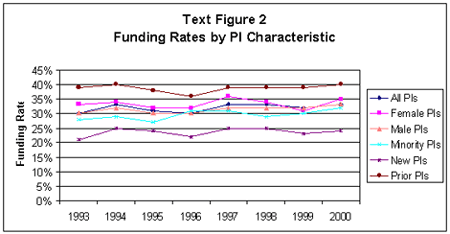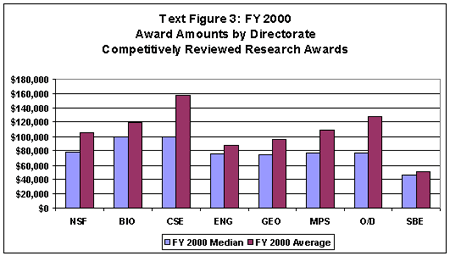
FY 2000 Report on the NSF Merit Review System
Among the Federal agencies, NSF has a unique mission: to strengthen the overall health of U.S. science and engineering across a broad and expanding research and education frontier. NSF invests in the best ideas from the most capable people, determined by competitive merit review. The merit review system is at the very heart of NSF's selection of the projects through which its mission is achieved. NSF evaluates proposals for research and education projects using two criteria: the intellectual merit of the proposed activity and the broader impacts of the proposed activity on society.
The FY 2000 Report on the NSF Merit Review System responds to a National Science Board (NSB) policy endorsed in 1977 and amended in 1984, requesting that the Director of the National Science Foundation (NSF) submit an annual report on the NSF proposal review system. This report provides summary information about levels of proposal and award activity and the process by which proposals are reviewed and awarded.
1. Proposals and Awards
Competitively Reviewed Proposals, Awards and Funding Rates
During FY 2000, NSF took action on 29,407 competitive, merit reviewed research and education proposals, as shown in Text Figure 1. The number of proposals reviewed annually by NSF has remained stable over the past decade.
NSF funding was awarded to 9,762 of the proposals, resulting in an overall funding rate of 33 percent. This rate has ranged from 30-34 percent over the past ten years. As shown in Appendix Table 1, 1 there are significant differences in the funding rates of the NSF directorate, ranging from 25 percent for the Engineering Directorate (ENG) to 39 percent the Geosciences (GEO) and Mathematical and Physical Sciences Directorates (MPS).
Text Figure 1
NSF Proposal, Award and Funding Rate Trends
Fiscal Year
1996 |
1997 |
1998 |
1999 |
2000 | |
|---|---|---|---|---|---|
Proposals |
30,230 |
30,189 |
28,319 |
28,501 |
29,407 |
|
Awards |
9,070 |
9,864 |
9,280 |
9,112 |
9,762 |
|
Funding Rate |
30% |
33% |
33% |
32% |
33% |
There are many possible reasons for these differences. For example, since funding rates are lower for new PIs, directorates (such as ENG) with a higher than average proportion of proposals from new PIs will have lower than average funding rates.
In addition to funding proposals that were competitively reviewed during FY 2000, NSF awarded 6,683 continuing grant increments (CGIs) based on proposals which had been competitively reviewed in earlier years. CGIs are funded in annual increments from current year appropriations. The CGI procedure complements the other major type of NSF award instrument - standard grants - where all funds for a multiple year project are obligated in the initial award. NSF policy limits the amount of next year's CGI commitments to 65 percent of a program's current fiscal year operating plan.
Characteristics of Principal Investigators
Trends in funding rate for all Principal Investigators (PIs), female and minority PIs2, and prior and new PIs are shown in Text Figure 2 below. Proposals, awards, funding rates and trends by PI characteristics are presented in Appendix Table 2.
During FY 2000, female PIs received 1,932 awards, a 16 percent increase. The funding rate was 35 percent, compared to 33 percent for male PIs. During the past few years, these funding rates have varied within a narrow range.
More significantly, since 1993 the number of proposals received from female PIs has increased by 18 percent and the number of awards has increased by 32 percent. During FY 2000, about 19 percent of competitively reviewed proposals were from female PIs, who received 20 percent of the awards.

In FY 2000, the number of awards to minority PIs increased to 482, a 14% increase over FY 1999. Still, this is only about five percent of the total number of NSF awards. The funding rate for minority PIs is 32%, slightly less than the overall rate of 33%. During the past decade, the minority funding rate has usually been 1-3 percentage points below the overall funding rate. Proposals have remained fairly level while the number of awards has increased only slightly.
In FY 2000, NSF established a GPRA goal to identify mechanisms to increase the number of women and underrepresented minorities in the proposal applicant pool, and to identify mechanisms to retain that pool (see page 16). In FY 2001, NSF will build on the results of this goal by targeting the reviewer pool.
There continues to be a wide disparity in the funding rates of "new PIs"3 and "prior PIs" (24 percent and 40 percent, respectively in FY 2000). One possible reason for this trend is that prior PIs are more likely to cite the results of previously funded projects in their subsequent proposals. Reviewers tend to favor PIs with proven track records.
As indicated in Appendix Table 2, in FY 2000 new PIs submitted 12,320 proposals, up slightly from FY 1999 but down by 15 percent from FY 1993-94 levels. In order to encourage the proposal process to be open to new people and ideas, NSF has established an FY 2000 GPRA performance goal of 30 percent of competitive research grants going to new investigators. As discussed on page 16, the FY 2000 result was 27 percent. In FY 2001 NSF will increase its efforts to promote awareness of the research opportunities at NSF open to new investigators.
Award Amounts
Data on median and average award amounts4 from FY 1996-2000 are presented by directorate in Appendix Table 3 and Text Figure 3.
The average annualized award amount in FY 2000 was $105,839, an increase of 13 percent from FY 1999. The average amount for female PIs was $95,987, compared to $108,825 for male PIs. The average amount for minority PIs was $88,743. Although each directorate increased its average award amount in FY 2000, the increase in the Computer and Information Science and Engineering (CISE) directorate was particularly large ($111K to $157K). This was due to a very large program solicitation in (Information Technology Research) which had a focus on large projects.
Adequate award size is important both to getting high quality proposals and to ensuring that proposed work can be accomplished as planned. Larger awards will increase the efficiency of the system by allowing scientists and engineers to devote a greater portion of their time to actual research rather than proposal writing and other paperwork. In NSF's FY 2001 Government Performance and Results Act (GPRA) Performance Plan, a specific goal is to increase the average annualized award size for research projects to $109,000, and the average award duration from 2.8 to 3 years.
__________
1 The term "directorates" as used in this report, refers to NSF's seven programmatic directorates and the Office of Polar Programs.
2 Minority includes American Indian or Alaskan Native, Black, Hispanic, and Pacific Islander and excludes Asian and White, not of Hispanic Origin.
3 A proposal is counted in the New PI subcategory if the PI was not a PI on a previous NSF Award.
4 The difference between the median and average award amounts reflects the effect of numerous small awards on the median, and a few large awards for centers, facilities, and large systemic initiatives on the average award amount.
